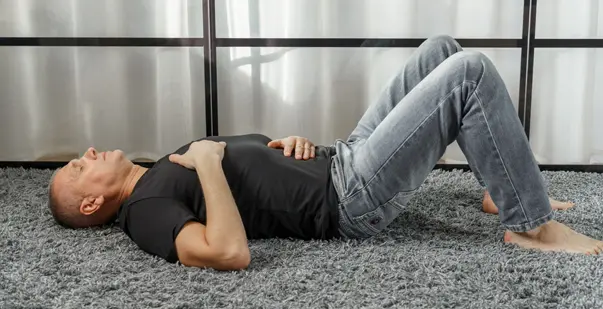
Last Updated on: September 11, 2024
Table of Contents:
Research shows that around 6-12% of the global population has chronic breathing pattern disorders. Imagine taking a deep breath, but instead of expanding, your chest contracts with air. This unusual phenomenon is known as paradoxical breathing. It is a breathing pattern disorder where the natural mechanics of the breathing process are altered, leading to noticeable symptoms and discomfort.
Paradoxical breathing is not just a medical condition; it is a critical sign that medical professionals use to assess respiratory well-being. Although it might sound alarming, understanding this condition is crucial for proper recognition and treatment. In this blog, we will provide valuable insights into paradoxical breathing to help you secure better respiratory health.
Breathing is a fundamental and often unconscious act, and that plays an essential role in sustaining life. Paradoxical breathing is a type of breathing pattern disorder, or dysfunctional breathing, that can occur in both adults and children.
Next question may arise: Is Paradoxical breathing dangerous? Well, if left untreated, it can cause respiratory distress and musculoskeletal imbalances.
In a typical breathing pattern, the chest wall expands as you inhale and contracts as you exhale. However, in the paradoxical breathing pattern, these normal movements are reversed. This can be particularly alarming, as your chest and abdomen may appear out of sync.
Paradoxical breathing usually occurs due to diaphragmatic dysfunction, a complex condition that is challenging to diagnose. Researchers are still uncertain about the exact causes of paradoxical breathing and its underlying conditions. However, certain factors can make individuals more susceptible to developing paradoxical breathing. Some of them are,
Paralysis of the diaphragm is one of the primary paradoxical breathing causes, which can result from medical or traumatic events, is a primary cause of paradoxical breathing. This rare condition occurs when the diaphragm is paralyzed or weakened due to damage to the spinal cord or conditions affecting the nerves or muscles from the brain to the diaphragm.
When the diaphragm is weakened, the chest wall muscles must compensate for breathing. This can cause abdominal contents to move towards the chest when inhaling and away from the chest when exhaling. Paradoxical breathing tends to worsen when lying flat and improves when standing.
Trauma or injury to the chest wall can cause the ribs to detach, preventing the chest wall from expanding properly during inhalation. In some cases, the detached section may push inward, leading to paradoxical breathing.
Obstructive sleep apnea disrupts the flow of oxygen and the expulsion of carbon dioxide, causing the chest wall to turn inward instead of outward. This disruption can result in paradoxical breathing.
Mineral deficiencies such as magnesium, potassium, and calcium can significantly impact breathing. For instance, calcium deficiency can affect the nervous system and disrupt breathing patterns. Conditions like diarrhea, malnutrition, vomiting, and certain metabolic disorders can also lead to an electrolyte imbalance, causing respiratory issues like paradoxical breathing.
The phrenic nerves control the movement of the diaphragm and other important muscles. Nerve damage, which can result from neurodegenerative diseases like multiple sclerosis, muscular dystrophy, and Guillain-Barre syndrome, as well as chest wall injuries or lung cancer, can disrupt normal muscle movement and lead to paradoxical breathing.
In some medical cases, the muscles that support the respiratory system can become weak, disrupting normal breathing patterns and resulting in paroxysmal breathing. This type of muscle weakness can be observed in neuromuscular conditions such as multiple sclerosis and amyotrophic lateral sclerosis.
Hormones, which act as chemical messengers in your body, play a crucial role in regulating various functions, including the respiratory system. Hormonal imbalances can alter your breathing patterns and lead to paradoxical breathing.
When a foreign particle or object blocks the upper airway—such as the throat, nose, or upper part of the windpipe—it can cause paradoxical breathing. This typically occurs due to an allergic reaction, throat swelling, choking, or severe respiratory infection.
Read More: How Does Online CPR Certification Make Healthcare Providers’ Lives Easy?
Paradoxical breathing symptoms are usually characterized by chest pain and a reversal of the normal movements of the chest and abdomen during breathing. The condition can be distressing and may indicate underlying health issues. Identifying these symptoms is crucial for a timely and accurate diagnosis. Some key symptoms that vary in intensity and manifestation include:
The intensity of symptoms associated with paradoxical breathing can vary greatly and may not be present in every case. The occurrence and severity of symptoms depend on the underlying cause of the condition and the individual’s overall well-being.
Read More: Chemical Burns: First Aid Treatment and Prevention Tips. (cprcourseonline.com)
Accurate and timely diagnosis is essential for effective treatment. Diagnosing paradoxical breathing involves a combination of clinical assessment and diagnostic tests to identify the underlying cause and extent of the condition. This process includes:
Once diagnosed, treatment for paradoxical breathing focuses on addressing the underlying cause and alleviating symptoms. Let us explain the Paradoxical breathing treatment in brief.
Paradoxical breathing is a complex condition that can have severe consequences for both health and quality of life. Recognizing the symptoms and seeking timely medical attention through effective online training are crucial steps. While overcoming the condition can be challenging, several treatment options and therapies are available to help you regain control of your breathing, improve lung function, and enhance overall well-being.
If you or someone you know is struggling with paradoxical breathing, consulting a healthcare professional is the first step towards finding a solution and making breathing easier once again.